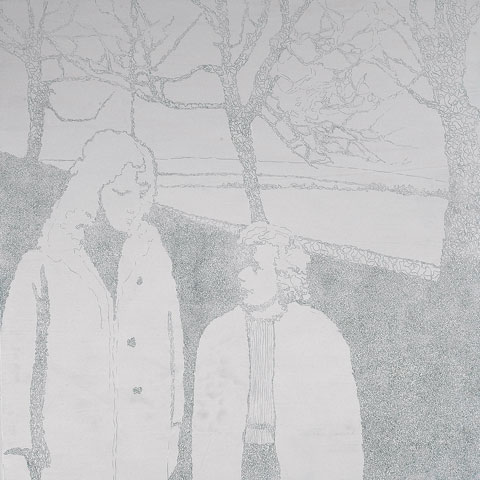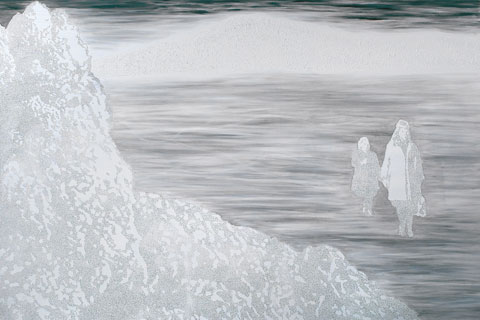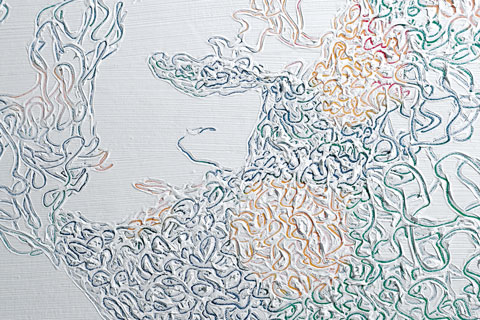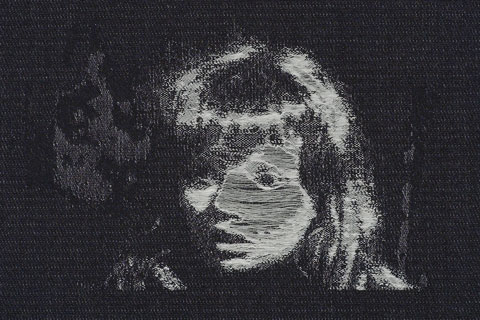Short interview with academic and painter Barbara Howey.
Natalie Dekel: I know from reading your PhD thesis that your mother’s passing led you to start painting. Do you still feel that painful moments from the past lead you to create your current works? [1]
Barbara Howey: The death of my mother did act as a catalyst for going to art school initially. The work I did based on old photographs of my mother came from thinking through aspects of feminist theory, particularly the work of Luce Irigaray, Je Tu Nous, in particular. It was feminist theory and practice that has enabled me to find a voice for enacting a relationship in my work to aspects of autobiography and memory. [2]
Do you think that this artistic way of dealing with the past or restructuring one’s memories is gender fixed? I mean, is it that important to you that your particular memories are related to the fact that you are a woman? [4]
Yes, I think making work is tied with my autobiography and memory which is all to do with my gender. I am a woman and all my experience has been to do with being a woman and so I find it impossible to think of myself outside of this. I know that this could be construed as essentialist but I can’t see any way round this. I do think that women experience the world differently within a masculine society, which I think in the West we still are and globally we definitely are. I also think, however, that making a work based on memory can transgress gender positioning as it is to do with how memories are retrieved, misremembered, forgotten and fragmented. [5]
Why do you think that you – as an artist – bring to attention these particular issues in your work (absences/presences, memories, womanhood, etc.)? Why this particular issues of womanhood and memories? [6]
This was as much to do with being a painter in the 1990s. Women were making works on these issues then and it was great to feel that at last you could have integrity around your own artwork and that women painters were finding a voice for this. I am thinking of Rebecca Fortnum, Jo Bruton, Sadie Murdoch and Rachelle Feinstein in America (who was making some witty interventions into abstract expressionist painting). [7]
Carl Andre said that art is a meditation between the conscious and the subconscious and the world (in an interview for Peter Fuller, May/June 1978). Do you agree with that? [9]
Yes, it can be. It depends on the art and the artist. In my own work I think there is this mediation, as work that I make that is too conceptual lacks what I can only call life and appears overly contrived. [10]
How would you describe your painting technique? [11]
I think technique is firstly to do with how you wish to express your ideas through the medium of paint. My technique has changed as my ideas have developed. It comes through a lot of experimentation which means a lot of work is discarded before I reach any kind of place which seems to say something about these ideas. It is quite a struggle really. [12]
So, can you see an evolution of subject and technique in your work? [14]
Yes, I do, and although it is a struggle to constantly reinvent yourself through your work I wouldn’t see the point if the work remained static. [15]
Would you say that engaging with your paintings is a process of learning the way you think and perceive yourself? [16]
Yes, I think it is a dialogue with the self but through a medium which, if it works, communicates with others. [17]
How do you identify yourself as an artist? Is it through your painting, or the way you think, or any other ways? [18]
Yes, it does seem a rather grand title to give oneself. I have a few roles as painter, writer, maker, lecturer, curator and so all these perhaps lead me to identify with the term artist, although I am sure it is different for everyone. [19]
Is going through a PhD research (thinking critically and analytically) helped you in your art practice? [20]
Yes, it has helped me to think critically. I find it a strange position that anyone can think that painting springs from some unknown source. It has a history, a context, and in order to make anything which approaches a position in relation to these you have to make yourself aware of them. [21]
Would you say that art springs from life experiences, where artists recapture these experiences or deal with their emotional intensity through art? [22]
It could be but I think the nature of art is very wide and there are many types of art. I used my personal experiences as a political strategy to give a voice to mother/daughter relationships. I can only speak for myself. [23]
Does your work explore in a way a mode of presentation and the way images become visible, how they acquire their visibility? [25]
Yes, it does. I am very interested in the fragility of the image of memory and of representation. That it can be vulnerable and fleeting and this is what I try to evoke… [26]
28 October 2009.
Images © Barbara Howey. Text © Barbara Howey and Natalie Dekel.
Interview conducted via email correspondence April 2009.
Barbara Howey is based in Norwich, UK. Natalie Dekel is based in Southampton, UK.






 - Reading with Natalie, book here...
- Reading with Natalie, book here...